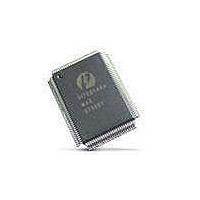PI7C7300DNAE Pericom Semiconductor, PI7C7300DNAE Datasheet - Page 46

PI7C7300DNAE
Manufacturer Part Number
PI7C7300DNAE
Description
IC PCI-PCI BRIDGE 3PORT 272-BGA
Manufacturer
Pericom Semiconductor
Datasheet
1.PI7C7300DNAE.pdf
(107 pages)
Specifications of PI7C7300DNAE
Applications
*
Interface
*
Voltage - Supply
*
Package / Case
272-PBGA
Mounting Type
Surface Mount
Maximum Operating Temperature
+ 85 C
Minimum Operating Temperature
- 40 C
Mounting Style
SMD/SMT
Operating Supply Voltage
3 V to 3.6 V
Supply Current (max)
660 mA
Lead Free Status / RoHS Status
Lead free / RoHS Compliant
Available stocks
Company
Part Number
Manufacturer
Quantity
Price
Company:
Part Number:
PI7C7300DNAE
Manufacturer:
Pericom
Quantity:
135
Company:
Part Number:
PI7C7300DNAE
Manufacturer:
MAX
Quantity:
5 510
5.3.1
Pericom Semiconductor
MEMORY-MAPPED I/O BASE AND LIMIT ADDRESS
REGISTERS
Memory-mapped I/O is also referred to as non-prefetchable memory. Memory addresses
that cannot automatically be pre-fetched but that can be conditionally prefetched based
on command type should be mapped into this space. Read trans-actions to non-
prefetchable space may exhibit side effects; this space may have non-memory-like
behavior. PI7C7300D prefetches in this space only if the memory read line or memory
read multiple commands are used; transactions using the memory read command are
limited to a single data transfer.
The memory-mapped I/O base address and memory-mapped I/O limit address registers
define an address range that PI7C7300D uses to determine when to forward memory
commands. PI7C7300D forwards a memory transaction from the primary to the
secondary interface if the transaction address falls within the memory-mapped I/O
address range. PI7C7300D ignores memory transactions initiated on the secondary
interface that fall into this address range. Any transactions that fall outside this address
range are ignored on the primary interface and are forwarded upstream from the
secondary interface (provided that they do not fall into the prefetchable memory range or
are not forwarded downstream by the VGA mechanism).
The memory-mapped I/O range supports 32-bit addressing only. The PCI-to-PCI Bridge
Architecture Specification does not provide for 64-bit addressing in the memory-mapped
I/O space. The memory-mapped I/O address range has a granularity and alignment of
1MB. The maximum memory-mapped I/O address range is 4GB.
The memory-mapped I/O address range is defined by a 16-bit memory-mapped I/O base
address register at configuration offset 20h and by a 16-bit memory-mapped I/O limit
address register at offset 22h. The top 12 bits of each of these registers correspond to bits
[31:20] of the memory address. The low 4 bits are hardwired to 0. The lowest 20 bits of
the memory-mapped I/O base address are assumed to be 0 0000h, which results in a
natural alignment to a 1MB boundary. The lowest 20 bits of the memory-mapped I/O
limit address are assumed to be FFFFFh, which results in an alignment to the top of a
1MB block.
Note: The initial state of the memory-mapped I/O base address register is 0000 0000h.
The initial state of the memory-mapped I/O limit address register is 000F
FFFFh. Note that the initial states of these registers define a memory-mapped I/O range
at the bottom 1MB block of memory. Write these registers with their appropriate values
before setting either the memory enable bit or the master enable bit in the command
register in configuration space.
To turn off the memory-mapped I/O address range, write the memory-mapped I/O base
address register with a value greater than that of the memory-mapped I/O limit address
register.
Page 46 of 107
3-PORT PCI-TO-PCI BRIDGE
November 2005 - Revision 1.01
PI7C7300D












